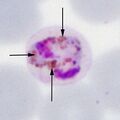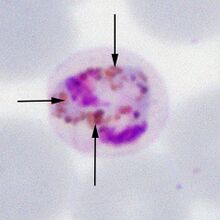Pig1.jpg and Malaria pigment: Difference between pages
From haematologyetc.co.uk
(Difference between pages)
No edit summary |
No edit summary |
||
| Line 1: | Line 1: | ||
---- | |||
'''Navigation'''</br> | |||
[[Plasmodium falciparum: Morphology|Go Back]] | |||
---- | |||
{| class="wikitable" style="border-style: solid; border-width: 4px; color:black" | |||
|colspan="1" style = "font-size:100%; color:black; background: FFFAFA"|<span style="color:navy>'''What is malaria pigment?'''</span> | |||
<gallery mode="nolines" widths="220px" heights="220px" > | |||
File:Pig1.jpg|link={{filepath:MPi1.jpg}} | |||
</gallery> | |||
A solid and angular late trophozoite form of ''P.malariae''. Note the golden pigment in separate clumps of granules distributed over the parasite surface (arrowed). | |||
<span style="color:navy>'''Description'''</span> | |||
During their development malarial parasites metabolise the haemoglobin within erythrocytes to support their growth - hence infected cells become "ghost cells" devoid of visible haemoglobin at later stages of parasite development. As part of that process the parasite must "detoxify" the iron component of the haem element. This process creates a detoxified iron containing protein "haemazoin" which is visible as pigment - as you might expect this is most visible at late stages of parasite development. | |||
<span style="color:navy>'''Species significance'''</span> | |||
Pigment may vary in colour and may be clumped or scattered as individual small masses depending on species; in some instances this can help (most obviously in the central clump seen in the "daisy head" schizonts of ''P.malariae''). Generally however, the form of the pigment is less useful than other features in determining species. | |||
<span style="color:navy>'''Additional images'''</span> | |||
Pigment in different stages of parasite development: | |||
<gallery mode="nolines" widths="220px" heights="220px" > | |||
</gallery> | |||
Revision as of 15:16, 28 March 2024
Navigation
Go Back
| What is malaria pigment?
A solid and angular late trophozoite form of P.malariae. Note the golden pigment in separate clumps of granules distributed over the parasite surface (arrowed).
Pigment may vary in colour and may be clumped or scattered as individual small masses depending on species; in some instances this can help (most obviously in the central clump seen in the "daisy head" schizonts of P.malariae). Generally however, the form of the pigment is less useful than other features in determining species.
Pigment in different stages of parasite development:
|
File history
Click on a date/time to view the file as it appeared at that time.
| Date/Time | Thumbnail | Dimensions | User | Comment | |
|---|---|---|---|---|---|
| current | 15:13, 28 March 2024 |  | 472 × 472 (60 KB) | Admin (talk | contribs) |
You cannot overwrite this file.
File usage
The following page uses this file:
